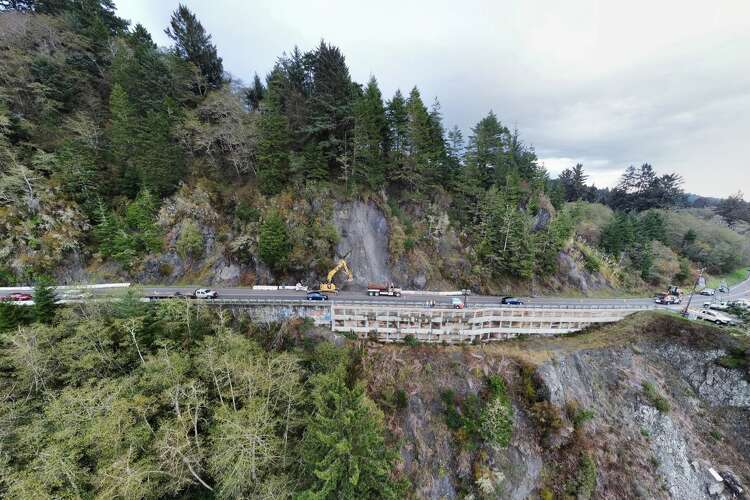How a Record-Breaking Tunnel Could Decide the Fate of One California County

A long-awaited solution is finally taking shape for one of the most dangerous and landslide-prone sections of California’s Highway 101. The proposed project—a massive tunnel—would become the longest in the state's history, addressing a decades-old issue that has plagued both travelers and residents alike.
The problematic area lies deep within the remote, forested region known as the Redwood Curtain on California’s far North Coast. Here, Highway 101 clings precariously to steep cliffs above the Pacific Ocean, forming an isolated stretch of road more than five hours north of San Francisco and nearly as far from Portland. When this highway fails due to landslides, entire communities like Crescent City and Klamath are effectively cut off from essential services and transportation routes.
This 3-mile stretch of highway sits atop a complex network of overlapping landslides. Caltrans officials have been monitoring slope movements, conducting field studies, and performing emergency repairs for years while working toward a permanent fix. That fix now appears to be a tunnel bypassing the unstable zone entirely.
Recently, the California Transportation Commission allocated $40 million to support the design phase of what is being called the Last Chance Grade Project. Located south of Crescent City in Del Norte County, the project involves constructing a 6,000-foot tunnel that would replace the most geologically unstable portion of Highway 101.
Currently, California’s longest highway tunnel is the Wawona Tunnel in Yosemite National Park, which stretches 4,233 feet through granite rock. The new tunnel would surpass it in length and provide a safer, more reliable passage through an area notorious for its frequent landslides.
According to the Environmental Impact Report, the proposed tunnel would bypass "the most intense area of known landslides and geologic instability," thereby eliminating the portion of Highway 101 most prone to closure.
The stakes are high in this remote part of the state. Highway 101 is not only the only north-south state highway in Del Norte County but also the only viable route between Klamath and Crescent City. A full closure between these two communities could result in a detour stretching over 449 miles, severely disrupting travel and commerce.
Cindy Vosburg, director of the Crescent City Chamber of Commerce, recalled a major landslide in February 2021 that closed the road for months. That event displaced schoolchildren and forced Klamath residents to endure an eight-hour detour just to reach basic services.
The landslide was significant—approximately 40,000 cubic yards of rock and debris crashed onto the highway following a powerful storm. Full road closure lasted for weeks, with lane restrictions continuing into late August as crews worked to clear debris and stabilize slopes.
Historically, landslides at Last Chance Grade occur once every few years, but they’ve become increasingly frequent in recent times. Between 2015 and 2018 alone, Caltrans spent $49 million on storm damage repairs, including replacing damaged retaining walls and restoring lost lanes.
Despite ongoing efforts, the hillside remains unstable. In October 2023, crews completed a series of new retaining walls, allowing for two-way traffic for the first time in nearly a decade. However, the following winter saw continued maintenance work, with crews clearing smaller slides and patching pavement along the narrow corridor between Wilson Creek and the northern end of Last Chance Grade.
For local residents and business owners, the impacts of repeated closures go far beyond inconvenience. Vosburg emphasized that such disruptions not only isolate tourists—who are crucial to the local economy—but also prevent access to medical care and essential goods like groceries.
Caltrans spokesperson Myles Cochrane described the recent $40 million allocation as “a significant milestone” in securing a lasting solution for this vulnerable stretch of roadway. It marks the beginning of the Plans, Specifications, and Estimates phase, which involves detailed engineering and design. That stage alone is expected to cost $225 million, with the remaining $185 million anticipated in 2026. Overall, the entire tunnel project is estimated to cost $2.1 billion.
Vosburg believes the future of the region depends on this infrastructure investment. She stated, “Without a lasting solution to the constant landslides on Highway 101, we face an uncertain future regarding the accessibility of this main road into Crescent City and onward to Oregon.”
While construction is currently projected to begin in 2030—with the tunnel opening by 2038—Caltrans is exploring ways to accelerate the timeline.
Valerie Stuckey, a Del Norte County supervisor, echoed the urgency of the situation. She noted that Last Chance Grade has long been a concern for local residents, who rely heavily on Highway 101 as their only direct southern connection. When the road closes, Klamath residents can’t access services in Crescent City, and emergency responders can't reach them either.
She concluded optimistically: “We look forward to a secure and safe passage into one of the most beautiful areas of California.”
Post a Comment for "How a Record-Breaking Tunnel Could Decide the Fate of One California County"
Post a Comment